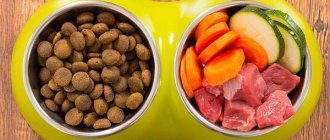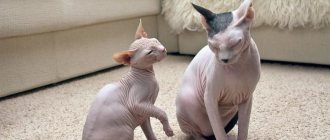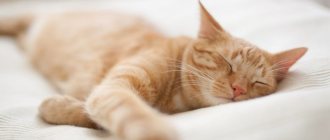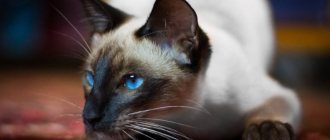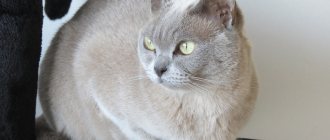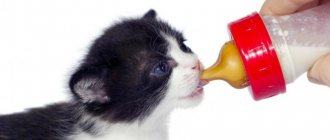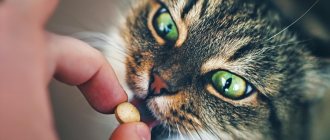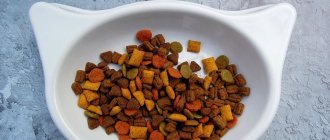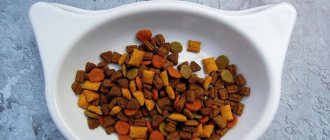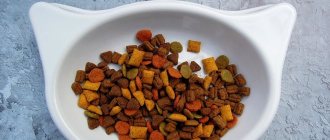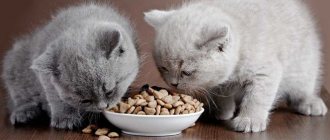The health of cats, like any pet, depends entirely on the care of the owner and his knowledge regarding the rules of keeping and feeding habits of the pet. By studying specialized literature and using the recommendations of veterinarians, you can choose the right optimal diet and understand how to feed your cat.
Principles of organizing a proper diet
If the owner has doubts about when and how often to feed the pet, it is worth adopting several techniques for optimally organizing cat dinners, which are recommended by veterinary experts.
Following these rules will help avoid digestive problems and protect against the development of obesity:
- Two feedings throughout the day is the answer to the question of how many times a day you need to feed your pet kitty. It is preferable to do this in the morning and evening. Please note that an adult cat should be fed according to this regimen. A small kitten should be fed five to six times during the day. They are transferred to two meals a day after six months of life.
- Feeding at the same hours. This rule disciplines the cat; he does not get used to begging from the master's table.
- Limiting feeding time. It takes a cat 20 minutes to satisfy his hunger and get enough. If during this time he has not eaten all the food, it is still better to remove the bowl of food. This will help avoid unnecessary overeating. If the cat begins to lazily eat the rest of the food, it means that he is already full enough.
- Single serving limit. You should not add a daily portion of food at one feeding.
Regardless of the time and number of feedings, fresh water should always be fully available to the cat.
How to make a cat's diet
First of all, a cat's feeding schedule depends on the type of diet that the owner prepares for him.
So, there are three common diets for cats:
- Human food from the table
- Natural food;
- Feed.
Food from the table
Many people who feed their pet food from their table do not even realize that they are greatly harming this animal.
Doing this is strictly prohibited, since the cat’s body suffers from many dishes and products that are usually consumed by humans.
Such “harmful” foods for animals include:
- Salty;
- Roast;
- Pickled;
- Sweet;
- Baked;
- Food with spices.
Cats often ask for human food, which is harmful to them
By consuming these categories of food from the human table, the cat gradually acquires health problems.
First of all, the following organs of the animal’s body are affected:
These problems require serious, sometimes surgical, treatment, which lasts quite a long time.
In addition, the process of treating a cat is stressful for it, and for the owner it is quite expensive.
Natural food
There is no consensus among veterinarians and breeders about what exactly is best to feed a cat - natural food or professional food.
This is explained by the fact that by choosing the right natural food for an animal, you can achieve a good balance of the nutrients it needs.
Consequently, the choice of whether to feed the cat natural food remains with the owner.
It depends on the time he has and the amount of money he is willing to spend on feeding his pet.
The healthiest meats for cats to eat are beef, turkey, chicken, duck and rabbit.
Natural food gives the animal an important feature - variety in the diet.
But proper preparation and menu preparation takes quite a lot of time, and at times, it is also more expensive than buying ready-made food .
In any case, you should not mix natural food with industrial food.
In addition, there are several foods that should not be given to cats.
These include:
By the way, raw and boiled eggs, raw fish and milk can be given to the animal occasionally.
The cat owner must clearly understand that these animals need a lot of protein.
They need it five times more than, for example, dogs.
This is why you should not feed your cat dog food if there are several types of pets living in the house.
Many cat lovers know that cats are picky eaters.
They may refuse to eat a particular dish out of pickiness.
To know more precisely what your cat will like, you need to experiment and make high-protein dishes, including protein sources such as:
By alternating or combining different protein foods in one dish, you can achieve a complete balance of nutrients and enrich your diet with a variety of tastes and textures.
Chocolate is a prohibited food for cats.
There are several foods that are highly desirable to include in a cat's diet:
- Heart. This organ is very useful for cats and includes taurine, an essential acid that is required for the full functioning of the body of these animals.
- Kidneys;
- Liver;
- Spleen;
- Brown rice;
- Pumpkin;
- Spinach;
- Carrot.
Brown rice is the best source of carbohydrates for a cat's body.
Feed
It is worth remembering that cat food is food made specifically for furry pets.
It includes the necessary components, vitamins and microelements that the animal needs to saturate the body.
There are three classes of cat food that differ in quality and price:
Feeds of this class include Darling, Whiskas , and Friskies.
They are also made with relatively cheap ingredients, such as meat by-products, soy, preservatives, dyes, and flavor enhancers.
It is worth noting that practically no vitamins are added to such foods, and they are low in calories.
When giving this food to a pet, the owner must understand that the animal is unlikely to get enough of the usual portion.
In addition, in this case it is necessary to give the pet vitamins and minerals in the form of an additional supplement.
When producing this class of food (“MeowMix”, “Cat Chow”, “ Sheba ”, “ Leonardo ”), the manufacturer uses natural meat and offal.
Vegetable protein is used - corn and preservatives.
It also does not contain enough vitamins and minerals, so they need to be given additionally.
Royal Canin is one of the most vitamin-rich cat foods
These foods, which are produced by such brands as Royal Canin , Hills , Nutra Mix, Ekanuba , Bozita , contain natural meat, a vitamin complex, as well as a list of minerals and fatty acids.
This class of food contains vitamin E as a preservative, which makes the food related to it significantly more useful compared to less expensive ones.
Cat diet in numbers
Feeding standards for cats depend on many factors:
- age;
- gender;
- size and weight;
- breeds;
- health conditions;
- lifestyle;
- type of food - dry, canned, natural products;
The question may arise: does the number of feedings depend on calorie content? Depends directly. This is one of the most important factors that determine the size of portions and their quantity throughout the day.
A cat will need more food if its food is low in nutritional value. It is better to choose a diet that, without compromising health, will satisfy the needs of twice feeding, morning and evening. It is better to choose a higher nutritional value over the amount of feed.
The optimal calorie content of the daily diet should be about 70 kcal per 1 kg of weight. Depending on the calorie content, the weight in grams of the daily norm is determined at the rate of 30-60 g per kg of the cat’s weight and is about 250 g.
Thus, an adult, healthy cat weighing 5 kg can eat 250 g of food per day with a total calorie content of 350 kcal.
Cats have a high need for amino acids. The meat and protein component in their diet is preferable to vegetables or cereals. Carbohydrates in the daily amount of feed should be no more than 3%, fats - no more than 15%.
Making up a diet
It is important that your cat's diet contains sufficient nutrients. But remember that their excess is just as harmful as their deficiency. Proper absorption also depends on the form in which they enter the body. To create the right diet, you need to take into account the individual needs of your pet. Size, age, lifestyle and special health needs matter. It is best to entrust the choice to professionals.
When creating PRO PLAN® food, knowledge and many years of experience in the field of nutrition are used, taking into account the needs of animals of different ages and health conditions. The developed products contain all the necessary nutrients in an easily digestible form. Different tastes allow you to accommodate the needs and preferences of even the most selective cats.
Reasons for adjusting average standards
There are several nuances that affect these numbers:
- a cat eats more food than a cat;
- more high-calorie food is necessary for an animal with high activity;
- after giving birth, the cat needs to be fed as many times a day as she asks;
- large breeds of cats also need to increase the average standards;
- Some cat breeds are prone to metabolic disorders. For them, dry food that is more balanced in composition is preferable;
- To maintain good reproductive function, a purebred stud cat must eat food with a high content of vitamin E.
When an animal begins to beg for food between set feedings and exhibit uncontrolled apatite, this may be a signal of parasite infection. Pets must be given deworming medications regularly.
To make sure your cat is getting enough food and has not lost or gained too much weight, regular weighings are recommended. If the indicators go significantly beyond the limits, it is necessary to reconsider the diet, its type, composition, and calorie content. The optimal average weight for most breeds is 2-4.5 kg.
Tips for owners
- Calculate the feeding rate in accordance with the manufacturer's recommendations on the packaging. For different brands, these indicators vary significantly, which is due to differences in energy density.
- Do not use additional vitamin or biologically active supplements: high-quality dry food already contains all the necessary vitamins, minerals and trace elements.
- Unlike dogs, cats do not require a strict feeding schedule. It is natural for them to stretch out their meals throughout the day and even eat at night.
- When a cat feeds dry food, its fluid intake increases. Make sure that clean drinking water is freely available around the clock and refresh it promptly.
Norms for kittens by month of life
The decision on how many times a day to feed a kitten depends on the baby's age in months. During growth and development, the cat's body requires more feedings throughout the day.
From birth and during the first month
If a newborn kitten is separated from its mother for any reason, then the responsibility of feeding the kitten falls on the shoulders of the person. If you couldn’t find another cat that could feed you with its own milk, you should feed the kitten without a mother a special formula. You can use infant formula for newborns.
It is forbidden to give a newborn kitten whole cow's milk in the first month of life; this is a very heavy food.
To develop the sucking reflex, it is advisable to use a bottle when feeding. You can try feeding from a pipette.
During the first three days you need to feed every two hours, including at night. Then, by the 10th day of life, the interval between feedings is increased to 4 hours. For the first two weeks, the daily intake of formula for a kitten is 30-40 ml per 100 g of baby’s weight.
A one-month-old kitten should be fed exclusively with formula, increasing its volume to 50-55 ml per 100 g of weight by day 30. Then start feeding him adult food.
1-2 months
The age of a kitten from a month to two months is the time to accustom it to food in pieces. By the end of the second month, the kitten should eat about 200 g of food, which is divided into 5 feedings. You can offer him oatmeal or rice milk porridge with the addition of a chicken egg. If ready-made food does not cause digestive upset, then you can completely switch the kitten to natural feeding.
2-3 months
A 2 month old kitten needs to be fed 4 times a day. He can already eat about 300 g of food, cut into small pieces. For example, you can offer minced meat.
3-4 months
A 3 month old kitten needs to be fed 3 times a day. The total volume of food eaten is approximately 360 g. Until this age, pieces of dry food must be soaked in water when feeding. At 3 months, kittens change their teeth and can already be introduced to solid food.
4 months and older
By this time, the kitten’s menu should consist of 75% meat protein foods.
Under no circumstances should you feed your kitten raw or fresh meat. This threatens protein intoxication or infection with parasites.
By six months, you can gradually transfer the grown kitten to two meals a day.
How many times a day should you feed a kitten?
Kittens need more frequent meals compared to adults. So, a newborn kitten, which is not more than 3 days old, should be given cat milk replacer from a pipette every 2 hours
. Moreover, without taking a break even at night. Although mother cats usually feed their babies themselves, there are special situations when this is not possible (as a result, for example, of the death of the female immediately after giving birth).
Kittens up to 2 months are fed every 6 hours
, gradually introducing adult food in crushed form into the diet (meat, cereals, vegetables, dairy products).
By 4-5 months, the baby can be switched to three meals a day
(morning, afternoon and evening).
And after 6-8 months, the kitten can be fed twice a day
, although some owners choose three meals a day for pets up to a year.
Nutrition for cats during special periods of life
The measured life of domestic cats changes greatly in some periods.
Illnesses and injuries, pregnancy, surgery, old age - all such changes in health require adjustments to the usual diet.
For example, nursing cats need more high-calorie food because their energy needs increase significantly. During the period of feeding kittens with milk, the volume of the daily diet should be increased, its nutritional value should be higher.
After sterilization or castration surgery, metabolism slows down in male cats. Therefore, their energy needs are reduced by approximately 25%. Appetite, on the contrary, may increase due to the lack of stress and dulling of the reproductive instinct. The owner should take these features into account in the postoperative period.
When preparing a diet for an animal after sterilization, you should give preference to low-calorie food. You can also feed a sterilized or neutered cat twice a day.
One should take into account the fact that after such an operation the frequency of urination decreases and the risk of developing urolithiasis increases. To avoid this, it is better to feed castrates with specialized food. Conventional food contains a lot of salt. This threatens the formation of kidney stones.
A sick cat usually needs a special diet, which is prescribed by a veterinarian. In especially severe cases, the animal has to be force-fed. After recovery and restoration of appetite, they return to their previous diet.
Elderly and aging cats' teeth deteriorate and other oral problems arise. Reviewing the cat's diet in this case is also very important. For example, replace dry food with canned food or introduce liquid natural dishes into the menu. You can leave only one feeding during the day. The optimal solution would be to reduce portions and increase the number of feedings. The diet of older animals should contain up to 10% carbohydrates.
Food allowance for an old cat
From 7/8 years old our animal will change from an adult cat to a senior cat and as a result their ability to digest proteins and fats will decrease. Therefore, it is necessary to continue to feed them 2 servings per day, but with high-quality and easily digestible food.
In addition to their ability to digest, we will notice other changes in our pet, such as the quality of the coat (less shiny). Or the amount of daily physical activity that makes them less active and energetic. However, this process is inevitable, but we can significantly extend the life of our companion if we feed him in a way that is appropriate for his age.
Industrial feed: pros and cons
Industrial animal feeds are divided into two types:
- wet food - canned food in the form of pates, pieces of meat with sauce;
- dry granulated food - small crackers.
Feeding natural food will require a lot of knowledge, patience and time. With skillful preparation of a correct and balanced menu, such nutrition will be healthier and safer.
Ready-made food has its advantages and disadvantages compared to natural food.
Industrial feed is better for several reasons:
- contains a complete balance of essential vitamins and microelements;
- easy to calculate and control the size and number of servings;
- long shelf life;
- feeding with dry food is more convenient;
- the opportunity to choose specialized veterinary food that meets the needs of a cat with health conditions.
Cats that eat only dry food must always have fresh water available.
Disadvantages of using industrial feed:
- high cost of quality feed;
- In canned food with sauce, more than half of the volume is water. Satiety with such food is reduced;
- high salt content, which threatens the development of urolithiasis;
- This food is addictive. It becomes very difficult to switch a cat to a different diet.
When feeding with ready-made store-bought food, you should pay attention to the mark indicating whether any type of food is complete. It can only serve as an additive to the main diet and does not satisfy all the nutritional needs of the cat.
When combining dry food with canned food, it is better to stick to the proportion - about 70% dry food and 30% canned food.
Some artificially bred cat breeds are susceptible to allergies and metabolic disorders. To maintain health, it is recommended to feed them only with fully balanced ready-made special food.
Basic principles of feeding at home
In nature, a cat is a predator. She catches small animals and birds and eats them whole, along with the contents of the stomach, wool and a small amount of feathers. The basis of the diet is meat, which is best digested raw. Plant foods should not form the basis of the diet: the cat’s body does not need large amounts of carbohydrates, and also does not digest coarse-fiber carbohydrates and fiber.
A balanced diet is key to keeping your pet active and healthy. It is desirable that his diet at home be close to “natural”. But choosing and preparing the right products is quite difficult. A veterinary nutritionist or an experienced breeder can do this, so it is better to use special food. They are made from carefully selected and processed ingredients, and do not contain spices and flavorings that are harmful to the animal, which are often included in homemade food.
Also, if you treat your cat with food from the table, this can form incorrect eating habits and the desire to beg or steal the foods they like.
The right utensils for feeding
When choosing a dish for your cat to eat from, it is better to give preference to a shallow plate with wide edges. If the container is small in diameter or has high edges, this will cause discomfort while eating, as the whiskers will cling to the edges of the plate. Cats' whiskers are an organ of touch, a kind of sensor with which they navigate in space.
To optimize the feeding process, you can use automatic or electronic feeders. They have the ability to customize for a specific feeding time and portion size.
You should not blindly and unconditionally follow the rules and recommendations when creating a menu for your pet. Each of them is unique and inimitable, with its own characteristics and preferences. Careful observation of the cat, its reaction to different products or industrial feeds will allow you to choose the most suitable feeding option.
How much does a cat need to eat? — General Considerations
If you're still wondering how much a cat should eat, here's what you need to consider:
- It is recommended to always leave cat food at their disposal because they can ration it themselves and only eat it when they are hungry and not for pure pleasure. If you don't do this, your cat will likely become anxious while waiting for food to arrive and may become stressed (with associated consequences).
- Cats are creatures of habit, so it is advisable for them to have a set daily routine as soon as they become adults.
- Following the routine task is to feed them every day in the same place and at the same time, in a quiet place and always away from their litter box.
- To feed your cat, use a mat or easy-to-clean surface on which you place a metal or ceramic bowl. Some cats prefer to eat in a flat feeder, and this helps them avoid eating too quickly.
- If you have more than one cat, you should make sure that each of them has an appropriate feeder at a considerable distance to prevent them from fighting or eating each other's food.
- Remember to keep an eye out for banned cat foods to avoid health problems.
Article by: Josie F. Turner Journalist specializing in animal welfare.
How to feed a cat correctly
Your cat's nutrition should be given special attention from the moment it arrives in your home. If possible, a small cat should be fed foods familiar to it so that it quickly adapts to new, unusual conditions. As your pet grows, you should increase the amount and calorie content of food . Also, the diet should be revised after the cessation of active growth to prevent the development of obesity. Feeding a pregnant or lactating cat requires close attention, as it directly affects the health of the future offspring.
When compiling a daily diet for a cat, keep in mind that protein should contain 60-65% of the total food.
Fats, carbohydrates and minerals account for the remainder. Dry food contains everything you need, so using it will make it much easier for you to organize proper nutrition for your pet.
© shutterstock
